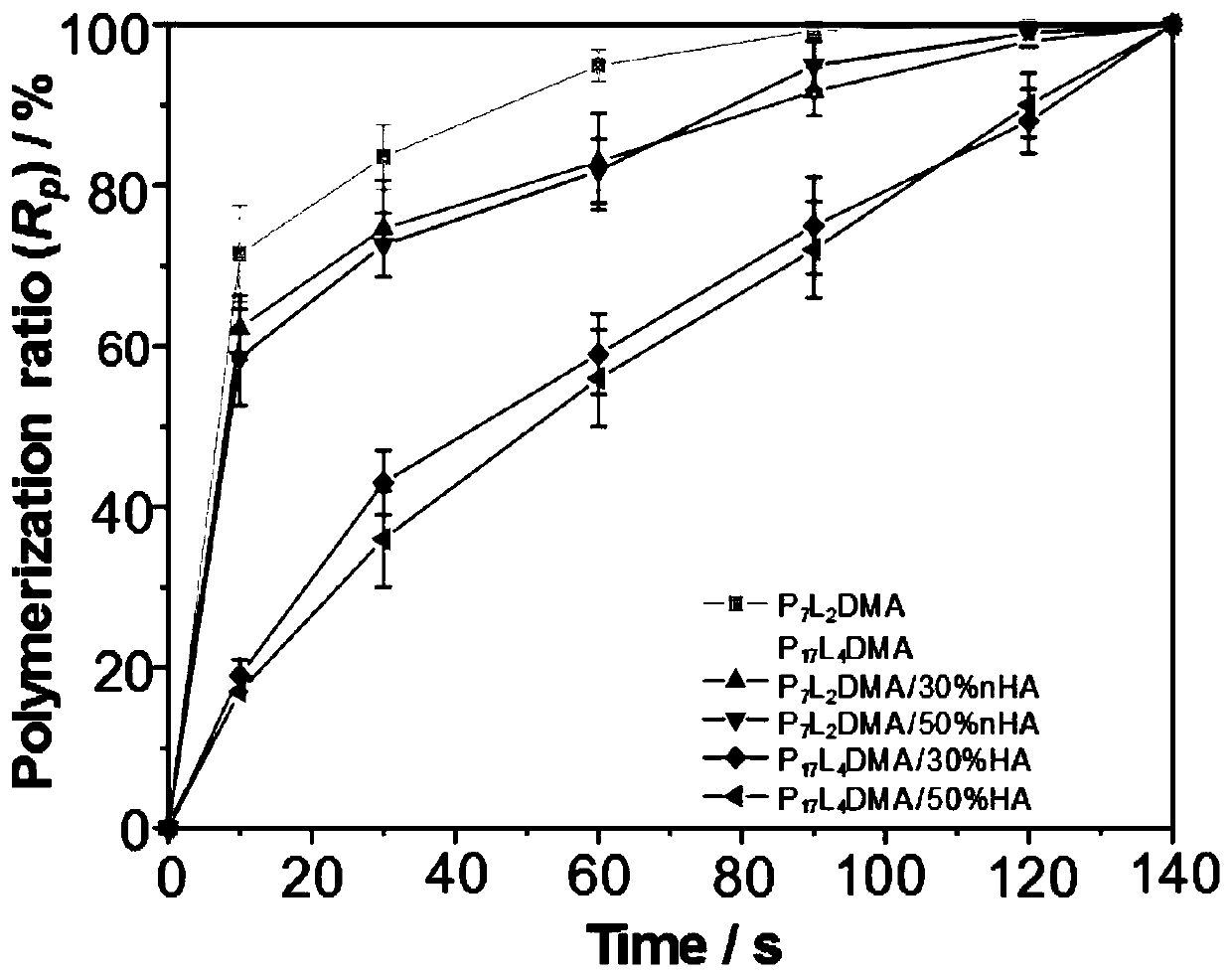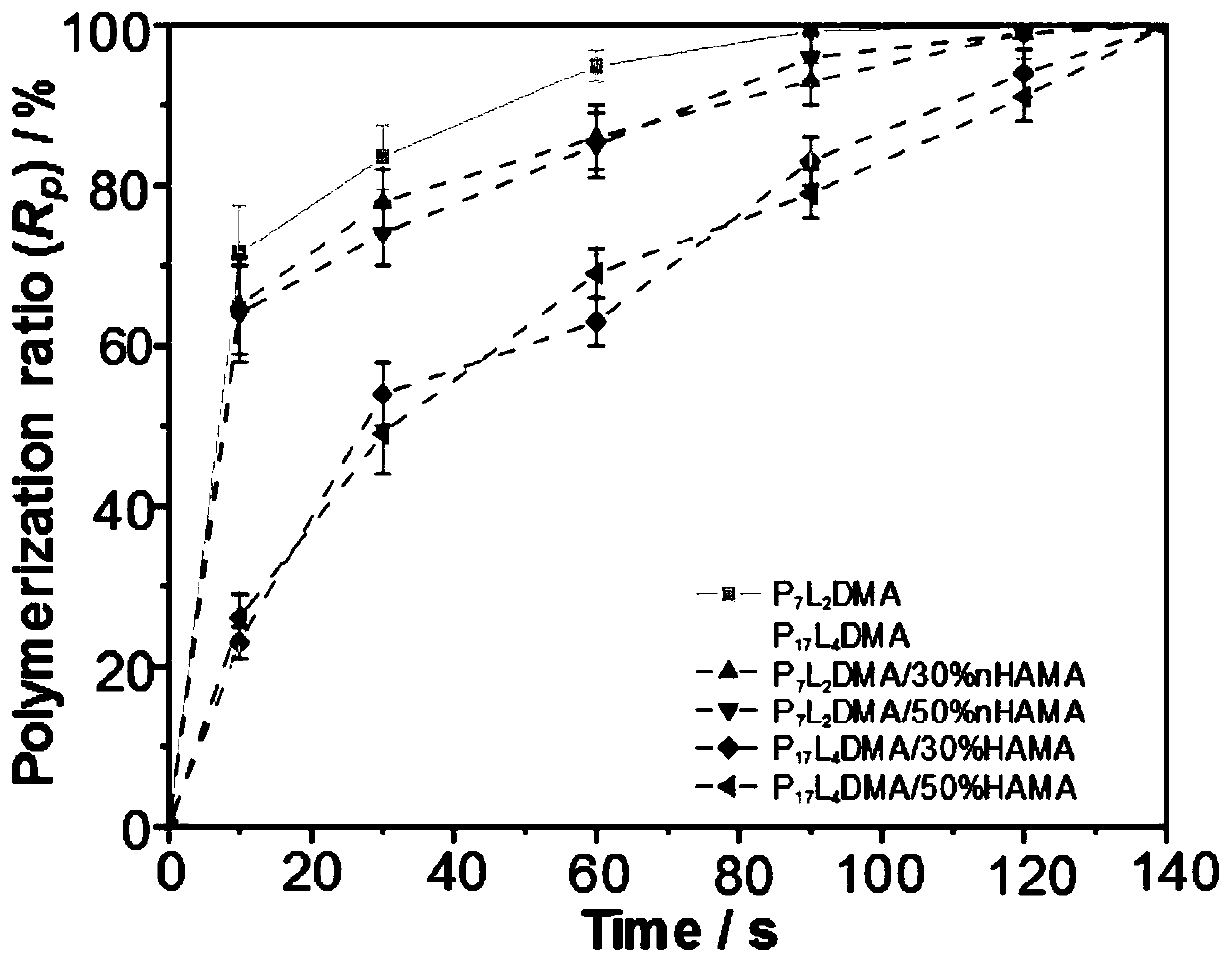Light curing composite for bone tissue engineering and bone tissue engineering bracket based on light curing composite
A technology of bone tissue engineering and composite materials, applied in the field of bone tissue engineering scaffolds and light-cured composite materials, can solve the problems of poor mechanical properties, biocompatibility and degradability of composite materials, serious cross-linking and exothermicity, etc., and achieve excellent mechanical properties. Properties and biological activity, reducing powder agglomeration, avoiding potential toxic effects
- Summary
- Abstract
- Description
- Claims
- Application Information
AI Technical Summary
Problems solved by technology
Method used
Image
Examples
Embodiment 1
[0072] 1. Light-cured composite materials for bone tissue engineering
[0073] The above photocurable composite material for bone tissue engineering is obtained by photopolymerization of polylactide-propylene glycol dimethacrylate and hydroxyapatite, wherein:
[0074] Polylactide-Propylene Glycol Dimethacrylate is P 7 L 2 DMA;
[0075] The content of hydroxyapatite in the composite material is 30%;
[0076] The ultraviolet light intensity used in photopolymerization is 5.5mW / cm 2 .
[0077] 2. Scaffolds for bone tissue engineering based on the above-mentioned composite materials
[0078] The above-mentioned bone tissue engineering scaffold is prepared by the following method:
[0079] (a) Establish the STL file of the three-dimensional model of the composite material, and process the STL file according to the microstructure of the three-dimensional model, and then export the STL file;
[0080] (b) Import the STL file into the 3D printer;
[0081] (c) Mix polylactide-pr...
Embodiment 2
[0083] 1. Light-cured composite materials for bone tissue engineering
[0084] The above photocurable composite material for bone tissue engineering is obtained by photopolymerization of polylactide-propylene glycol dimethacrylate and hydroxyapatite, wherein:
[0085] Polylactide-Propylene Glycol Dimethacrylate is P 7 L 2 DMA;
[0086] The content of hydroxyapatite in the composite material is 50%.
[0087] The ultraviolet light intensity used in photopolymerization is 5.5mW / cm 2 .
[0088] 2. Scaffolds for bone tissue engineering based on the above-mentioned composite materials
[0089] The above-mentioned bone tissue engineering scaffold is prepared by the following method:
[0090] (a) Establish the STL file of the three-dimensional model of the composite material, and process the STL file according to the microstructure of the three-dimensional model, and then export the STL file;
[0091] (b) Import the STL file into the 3D printer;
[0092] (c) Mix polylactide-pr...
Embodiment 3
[0094] 1. Light-cured composite materials for bone tissue engineering
[0095] The above photocurable composite material for bone tissue engineering is obtained by photopolymerization of polylactide-propylene glycol dimethacrylate and hydroxyethyl methacrylate functionalized hydroxyapatite, wherein:
[0096] Polylactide-Propylene Glycol Dimethacrylate is P 7 L 2 DMA;
[0097] The content of hydroxyapatite functionalized with methacrylic acid hydroxyethyl in the composite material is 30%.
[0098] The ultraviolet light intensity used in photopolymerization is 5.5mW / cm 2 .
[0099] 2. Scaffolds for bone tissue engineering based on the above-mentioned composite materials
[0100] The above-mentioned bone tissue engineering scaffold is prepared by the following method:
[0101] (a) Establish the STL file of the three-dimensional model of the composite material, and process the STL file according to the microstructure of the three-dimensional model, and then export the STL fi...
PUM
| Property | Measurement | Unit |
|---|---|---|
| Particle size | aaaaa | aaaaa |
Abstract
Description
Claims
Application Information
 Login to view more
Login to view more - R&D Engineer
- R&D Manager
- IP Professional
- Industry Leading Data Capabilities
- Powerful AI technology
- Patent DNA Extraction
Browse by: Latest US Patents, China's latest patents, Technical Efficacy Thesaurus, Application Domain, Technology Topic.
© 2024 PatSnap. All rights reserved.Legal|Privacy policy|Modern Slavery Act Transparency Statement|Sitemap



